2,4-Bis(trifluoromethyl)phenylboronic acid
Synonym(s):(2,4-Ditrifluoromethylphenyl)boronic acid;2,4-Bis(trifluoromethyl)benzeneboronic acid;2,4-Di(trifluoromethyl)benzeneboronic acid
- CAS NO.:153254-09-2
- Empirical Formula: C8H5BF6O2
- Molecular Weight: 257.93
- MDL number: MFCD01631349
- EINECS: 604-892-8
- SAFETY DATA SHEET (SDS)
- Update Date: 2024-04-08 16:27:35
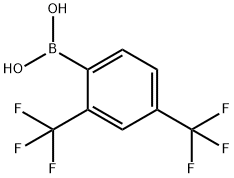
What is 2,4-Bis(trifluoromethyl)phenylboronic acid?
Chemical properties
White crystalline
The Uses of 2,4-Bis(trifluoromethyl)phenylboronic acid
Reactant for preparation of:
- Pyrrolo[2,3-d]pyrimidin-4-ones as corticotropin-releasing factor 1 receptor antagonists with a carbonyl-based hydrogen bonding acceptor
- Biaryl pyrazole carboxamides as sodium channel blockers for treatment of neuropathic pain
- Biphenylketones as dual modulators of inflammation and bone loss
- (Biphenylyl)pyrazolecarboxamides and their voltage-gated sodium channel Nav1.7 blocking structure-activity relationship
- N-hydroxyalkyl biphenylsulfonamides as inhibitors of bone resorption
- 1,3,6,8a-tetraazaacenaphthylene derivatives and study of their activity as corticotropin-releasing factor-1 antagonists
- Blue luminescent iridium phenylpyridine complexes
Properties of 2,4-Bis(trifluoromethyl)phenylboronic acid
| Melting point: | 148-150 |
| Boiling point: | 245.4±50.0 °C(Predicted) |
| Density | 1.50±0.1 g/cm3(Predicted) |
| storage temp. | Inert atmosphere,Room Temperature |
| solubility | soluble in Methanol |
| form | powder to crystal |
| pka | 7.40±0.58(Predicted) |
| color | White to Light yellow |
| CAS DataBase Reference | 153254-09-2(CAS DataBase Reference) |
Safety information for 2,4-Bis(trifluoromethyl)phenylboronic acid
| Signal word | Warning |
| Pictogram(s) |
 Exclamation Mark Irritant GHS07 |
| GHS Hazard Statements |
H315:Skin corrosion/irritation H319:Serious eye damage/eye irritation H335:Specific target organ toxicity, single exposure;Respiratory tract irritation |
| Precautionary Statement Codes |
P261:Avoid breathing dust/fume/gas/mist/vapours/spray. P264:Wash hands thoroughly after handling. P264:Wash skin thouroughly after handling. P280:Wear protective gloves/protective clothing/eye protection/face protection. P304+P340:IF INHALED: Remove victim to fresh air and Keep at rest in a position comfortable for breathing. P305+P351+P338:IF IN EYES: Rinse cautiously with water for several minutes. Remove contact lenses, if present and easy to do. Continuerinsing. P405:Store locked up. |
Computed Descriptors for 2,4-Bis(trifluoromethyl)phenylboronic acid
New Products
(S)-3-Aminobutanenitrile hydrochloride 4-Methylphenylacetic acid N-Boc-D-alaninol N-BOC-D/L-ALANINOL Tert-butyl bis(2-chloroethyl)carbamate 3-Morpholino-1-(4-nitrophenyl)-5,6-dihydropyridin- 2(1H)-one Furan-2,5-Dicarboxylic Acid Tropic acid 1-Bromo-3,5-Di-Tert-Butylbenzene S-2-CHLORO PROPIONIC ACID ETHYL ISOCYANOACETATE 2-Bromo-1,3-Bis(Dimethylamino)Trimethinium Hexafluorophosphate 4-IODO BENZOIC ACID 3-NITRO-2-METHYL ANILINE 1-(2,4-DICHLOROPHENYL) ETHANAMINE (2-Hydroxyphenyl)acetonitrile 4-Bromopyrazole 2-(Cyanocyclohexyl)acetic acid 4-methoxy-3,5-dinitropyridine 1-(4-(aminomethyl)benzyl)urea hydrochloride 2-aminopropyl benzoate hydrochloride diethyl 2-(2-((tertbutoxycarbonyl)amino) ethyl)malonate tert-butyl 4- (ureidomethyl)benzylcarbamate Ethyl-2-chloro((4-methoxyphenyl)hydrazono)acetateRelated products of tetrahydrofuran
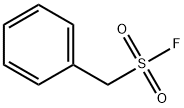
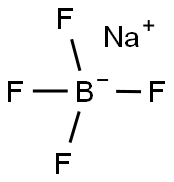

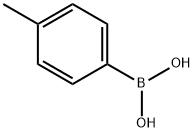

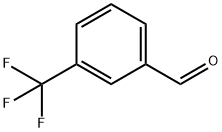
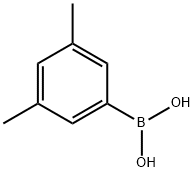

You may like
-
 2,4-Bis(trifluoromethyl)phenylboronic Acid (contains varying amounts of Anhydride) CAS 153254-09-2View Details
2,4-Bis(trifluoromethyl)phenylboronic Acid (contains varying amounts of Anhydride) CAS 153254-09-2View Details
153254-09-2 -
 2,4-Bis(trifluoromethyl)benzeneboronic acid CAS 153254-09-2View Details
2,4-Bis(trifluoromethyl)benzeneboronic acid CAS 153254-09-2View Details
153254-09-2 -
 1975-50-4 98%View Details
1975-50-4 98%View Details
1975-50-4 -
 2-HYDROXY BENZYL ALCOHOL 98%View Details
2-HYDROXY BENZYL ALCOHOL 98%View Details
90-01-7 -
 2-Chloro-1,3-Bis(Dimethylamino)Trimethinium Hexafluorophosphate 221615-75-4 98%View Details
2-Chloro-1,3-Bis(Dimethylamino)Trimethinium Hexafluorophosphate 221615-75-4 98%View Details
221615-75-4 -
 61397-56-6 CIS BROMO BENZOATE 98%View Details
61397-56-6 CIS BROMO BENZOATE 98%View Details
61397-56-6 -
 14714-50-2 (2-Hydroxyphenyl)acetonitrile 98+View Details
14714-50-2 (2-Hydroxyphenyl)acetonitrile 98+View Details
14714-50-2 -
 118753-70-1 98+View Details
118753-70-1 98+View Details
118753-70-1
Statement: All products displayed on this website are only used for non medical purposes such as industrial applications or scientific research, and cannot be used for clinical diagnosis or treatment of humans or animals. They are not medicinal or edible.